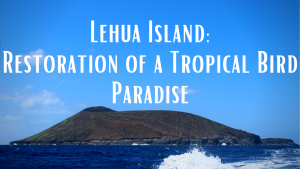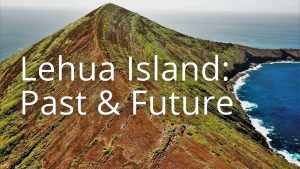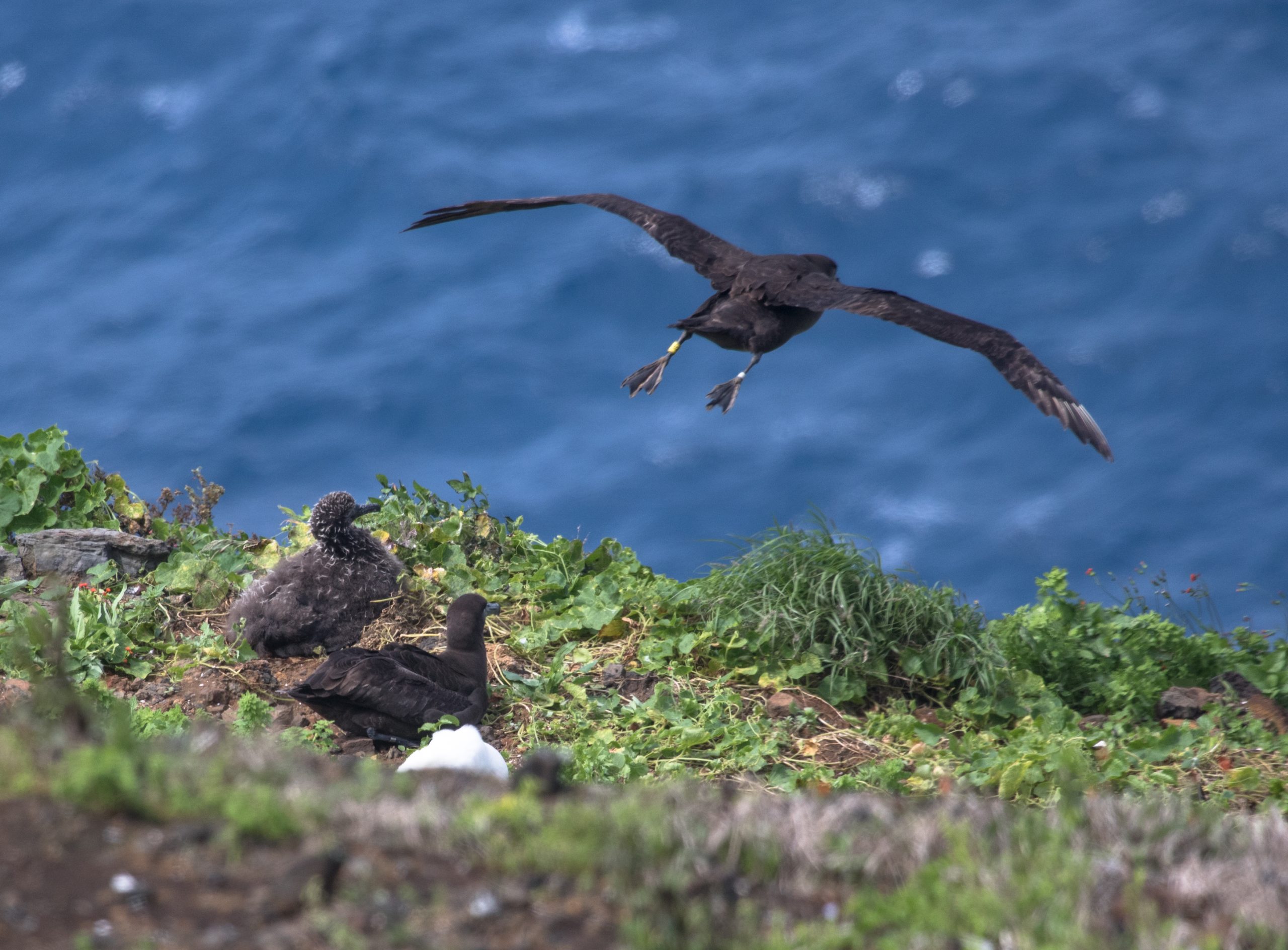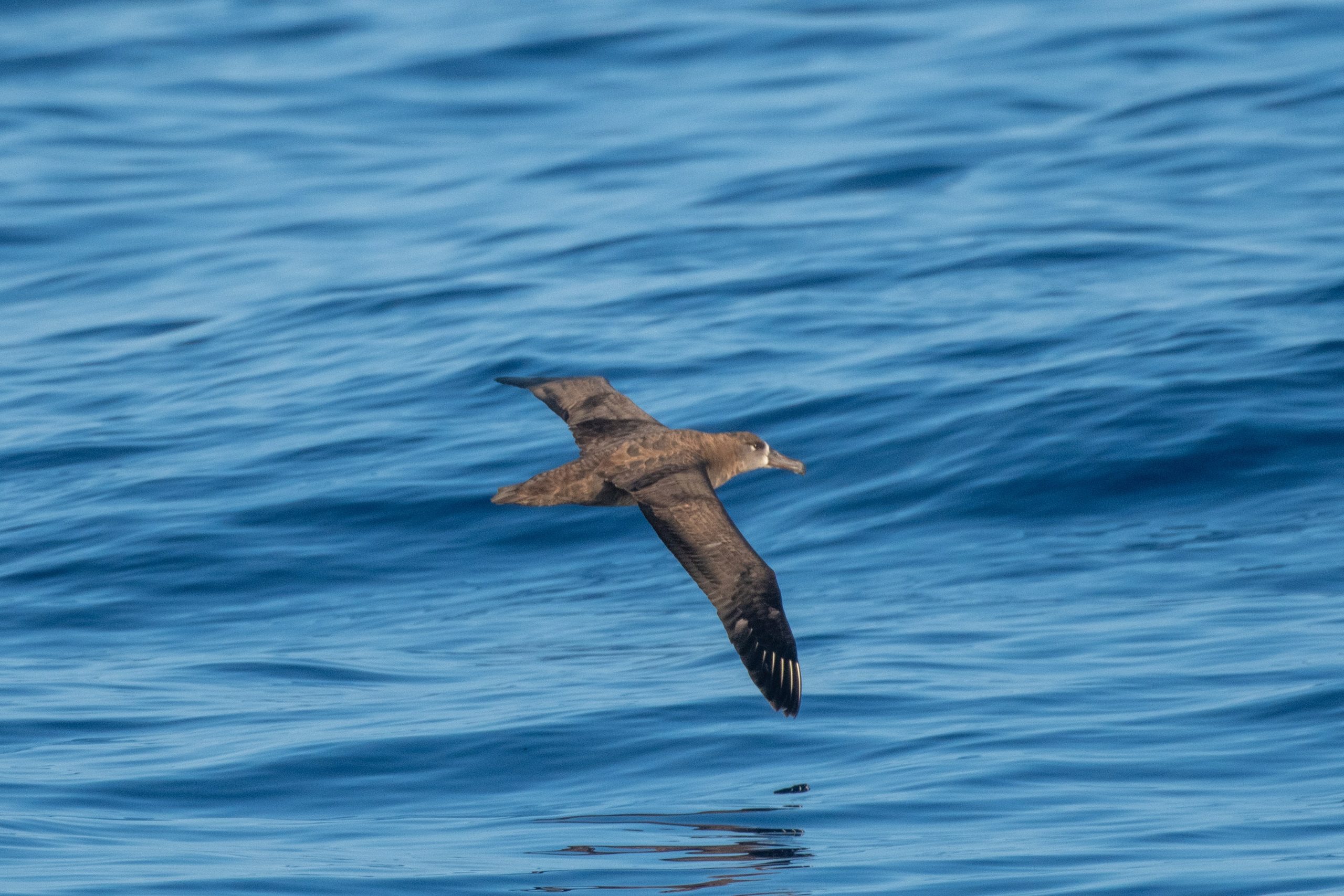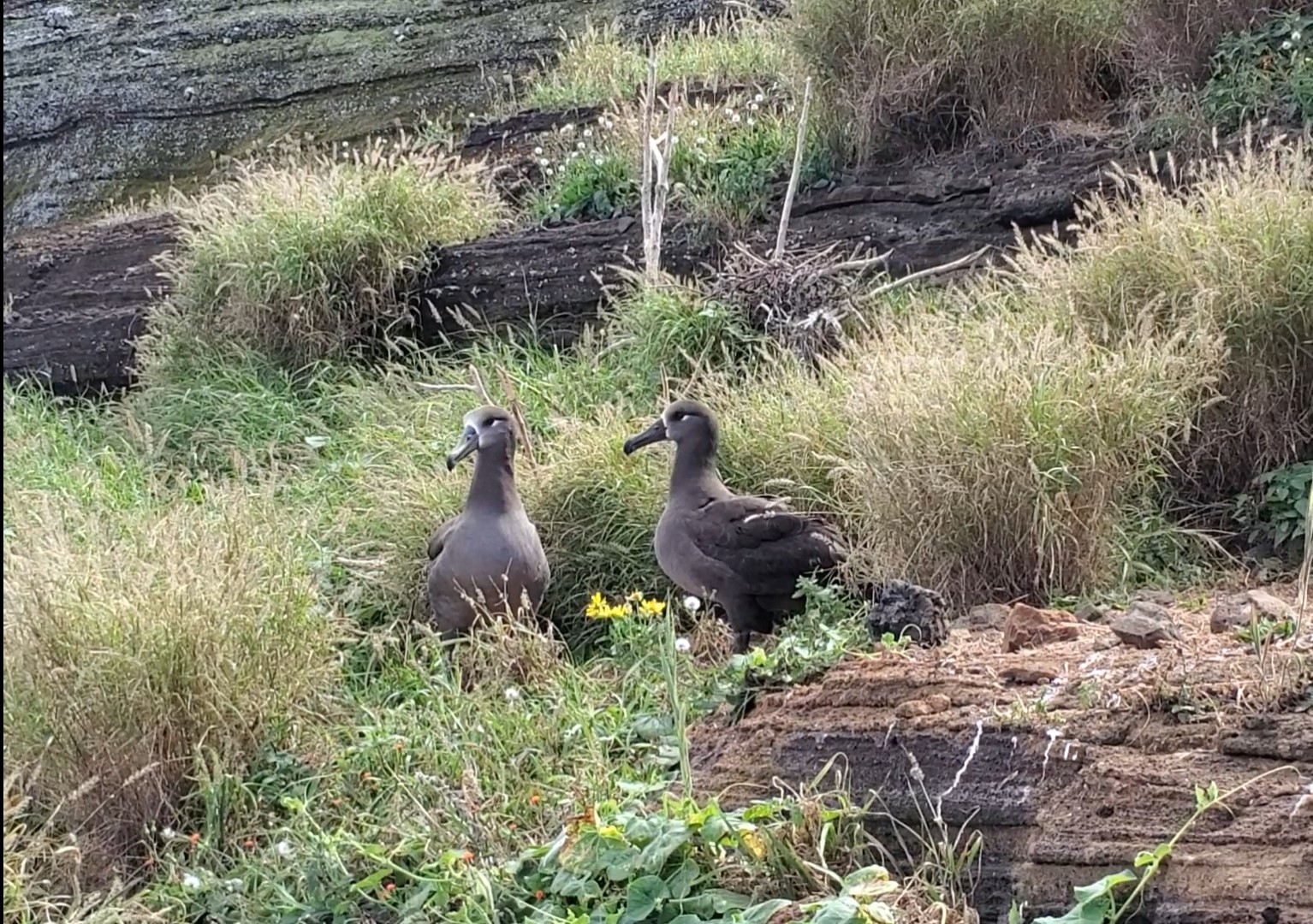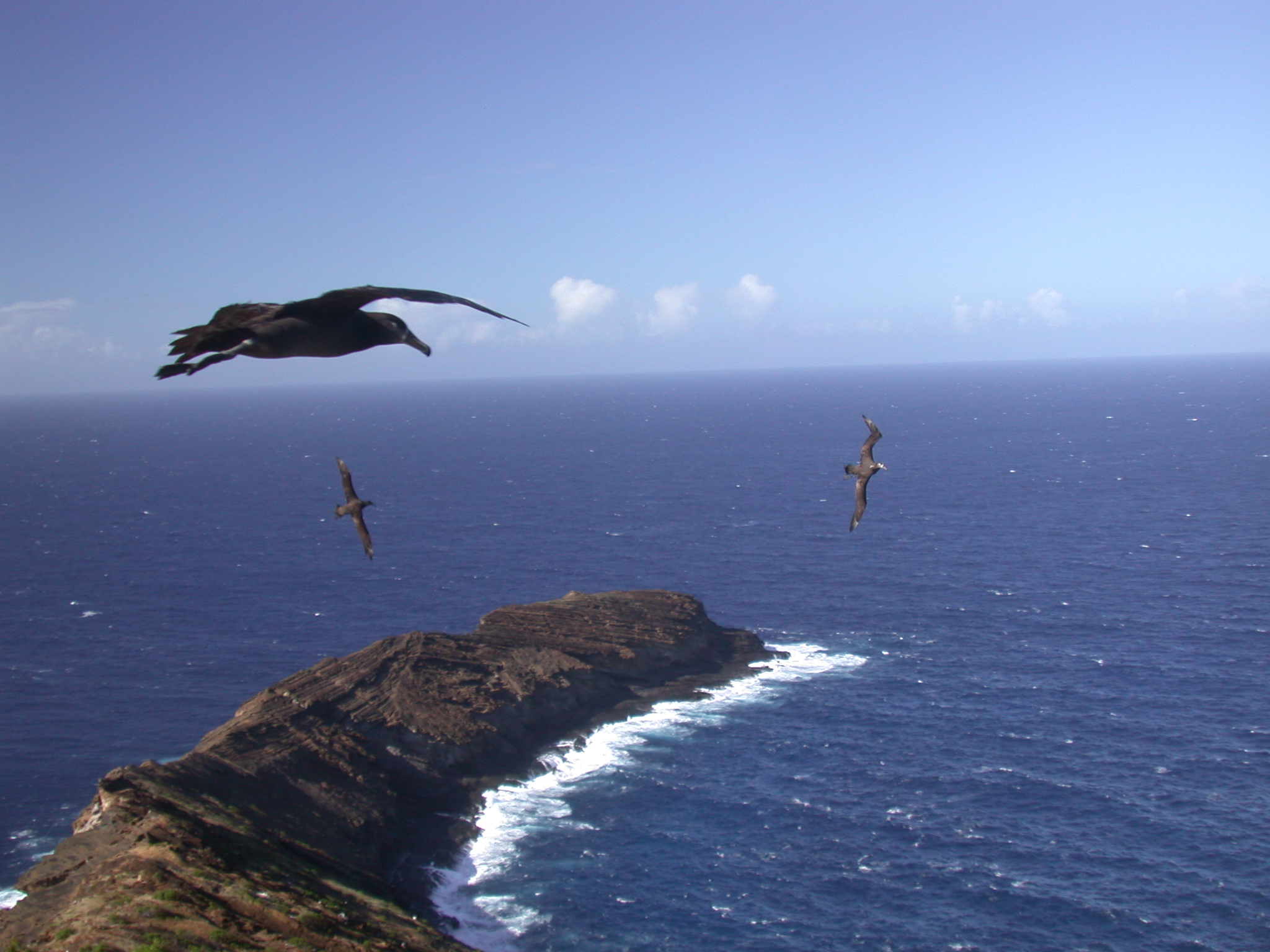Kaʻupu

Names
- ʻŌlelo Hawaiʻi: Ka‘upu
- Common: Black-footed albatross
- Scientific: Phoebastria nigripes, Diomeda nigripes
Song
Conservation Status
- IUCN Red List Ranking – Near Threatened
Species Information
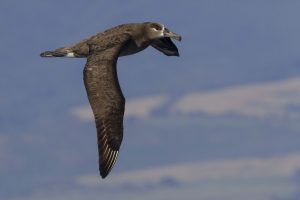
Kaʻupu or Black-footed Albatross. PC: Jacob Drucker
The ka‘upu or black-footed albatross is the smallest albatross (Family: Diomedeidae) in Hawai‘i. Adults are entirely black except for a narrow whitish area at the base of the bill and another under the eyes; 10 percent of the individuals also have a white rump and undertail coverts. Like all albatross, ka‘upu use dynamic soaring, a special flying technique to cover great distances. They feed from the surface by seizing prey while sitting on the water, and will “tipup” like ducks, using their well-developed olfactory sense to locate food. Ka‘upu form longterm pair bonds and exhibit high nest site fidelity, and do not breed every year. Nesting occurs in large colonies, and nests are placed in scooped out hollows on open, sandy beaches or dunes. Pairs engage in noisy, ritualized courtship dances. A single egg is laid in November and chicks fledge in June and July. Both male and female incubate egg, and brood and feed young. Young birds do not return to land until their third year after flying. These birds do not breed, but dance, build nests, and prospect for mates. Age at first breeding is at least five years old. The oldest-known black-footed albatross was at least 43 years old.
Distribution
Nests on all the Northwestern Hawaiian Islands (NWHI), and on Lehua Island off Ni‘ihau in the Main Hawaiian Islands (MHI). Outside of Hawai‘i, there are a few small nesting colonies off Japan and western Mexico. Historically, nesting occurred on several islands in the central and south Pacific, but no evidence of historical nesting on MHI. At sea, they occur widely throughout the north Pacific Ocean.
Habitat
Nesting colonies occur on low coral and sand islands. These birds use open sandy beaches or dunes for nest sites, or occasionally nest among vegetation. At sea, they occur over the open ocean.
Threats
- Historical human disturbance. Hunters decimated populations for the millinery trade. Military activities at nesting islands also took a heavy toll on this species; for example, tens of thousands were killed at Midway Island during the 1950s and 1960s to reduce collisions with aircraft.
- Fishery bycatch. Bycatch is one of the most serious threats to albatross; thousands were killed annually as bycatch in drift net fisheries prior to their ban in 1993, and in U.S. longline fisheries. Bycatch has been greatly reduced in the last 10–20 years by U.S. fisheries; however, bycatch from Japanese and Taiwanese fleets in the north Pacific Ocean remains a significant threat.
- Invasive species. Non-native plants, specifically golden crown-beard, degrades nesting habitat and may limit nesting and reduce productivity.
- Marine pollution. Adults ingest plastic debris, then feed it to their chicks, resulting in harm or mortality of chicks.
- Contaminants. Organochlorine levels high enough to result in eggshell thinning and embryonic defects have been detected in ka‘upu. Oil spills are also a threat.
- Climate change. Nesting colonies on open sandy areas near the shoreline are vulnerable to sea level rise and increased storms and wave events associated with climate change.
Learn more
Plans & Projects
Photos
Additional Resources
For more information and references visit the DLNR State Wildlife Action Plan factsheets. DOFAWʻs species pages and State Wildlife Action Plan fact sheets are provided for general information and are not meant to be a citable, original source of data. If you are a student, researcher, or writer looking for a citable source, please explore the references below or find other original data sources, rather than citing these webpages. The references below were provided by the authors of the State Wildlife Action Plan fact sheets at the time of drafting:
- IUCN Red List of Threatened Species. Version 2014.3. www.iucnredlist.org. (Accessed May 2015).
- NatureServe. 2015. NatureServe Explorer: An online encyclopedia of life [web application]. Version 7.1. NatureServe, Arlington, VI. Available at: https://explorer.natureserve.org. (Accessed May 2015).
- U.S. Fish and Wildlife Service. 2005. Regional seabird conservation plan, Pacific Region. U.S. Fish and Wildlife Service, Migratory Birds and Habitat Programs, Pacific Region. Portland, Oregon.
- Whittow GC. 1993. Black-footed albatross (Diomeda nigripes). In The Birds of North America, No. 65 (Poole A, Gill F, editors). Philadelphia, (PA): The Academy of Natural Sciences; and Washington DC: The American Ornithologists’ Union.
- VanderWerf, EA. 2012. Hawaiian Bird Conservation Action Plan. Pacific Rim Conservation, Honolulu, Hawai‘i.

